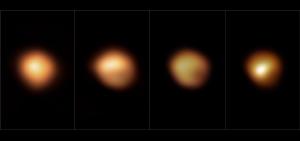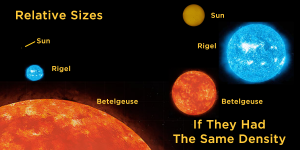Blog
The Great Dimming
23 June 2021
 ESO/M. Montargès et al
ESO/M. Montargès et alAt the beginning of 2020, the red giant star Betelgeuse started to dim significantly. Betelgeuse has been known to vary in brightness, but this one was unusual. It grew much dimmer than usual, and for a longer period. Since Betelgeuse is a star at the end of its life, it led some to speculate that perhaps it would go supernova. Astronomers didn’t think that was likely, and of course, Betelgeuse didn’t explode, and gradually its usual brightness returned. But astronomers were puzzled as to why Betelgeuse grew so dim.
One of the challenges to understanding Betelgeuse is that it’s very different from our Sun. While the surface of the Sun is very dense, the “surface” of Betelgeuse is very diffuse. Its diameter is wider than the orbit of Mars but its density is extremely low. So low that the surface region of the star is almost a vacuum. This means the outer layer of Betelgeuse is convective, where hot regions of gas rise to the surface, then cool and sink into the star. So one idea was that a particularly large region of gas reached the surface and cooled, thus making Betelgeuse appear dim.
 Brian Koberlein
Brian KoberleinBut a new study finds that Betelgeuse actually dimmed because of stardust.1 Observations of Betelgeuse from ESO’s Very Large Telescope (VLT) during the dimming period show that the dimming wasn’t due to a drop in surface temperature. Instead, it dimmed because a veil of dust obscured the star, blocking some of its light. The dust came from the star itself. A large bubble of hot gas rose from the surface and then cooled to the point that it condensed into dust.
What’s interesting about this discovery is that it shows a new way for heavier elements to get cast into space. Many of the elements other than hydrogen and helium are born through core fusion in a star, and these can be thrown into deep space during a supernova explosion. This new study shows that stardust can be tossed into space long before a star goes supernova, while it is still in the red giant stage. Since carbon, nitrogen, and oxygen would be common elements in these dusty outbursts, they could form complex molecules that are the raw materials for life.
Betelgeuse will become a supernova eventually. It won’t pose any threat to Earth, but it will be a wondrous sight. But before then it will likely have several more great dimmings, which will let astronomers further study the end of one star and the earliest beginnings of others.
Montargès, Miguel, et al. “A dusty veil shading Betelgeuse during its Great Dimming.” Nature 594.7863 (2021): 365-368. ↩︎